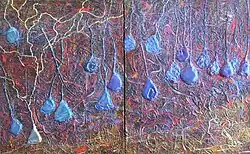Subiculum
| Subiculum | |
|---|---|
.jpg.webp) Subiculum labeled at center left. | |
 Subiculum to CA1 transition Artist Don Cooper and Leah Leverich | |
| Details | |
| Part of | Temporal lobe |
| Artery | Posterior cerebral Anterior choroidal |
| Identifiers | |
| Acronym(s) | S |
| NeuroNames | 188 |
| NeuroLex ID | birnlex_1305 |
| TA98 | A14.1.09.326 |
| TA2 | 5519 |
| FMA | 74414 |
| Anatomical terms of neuroanatomy | |
The subiculum (Latin for "support") is the most inferior component of the hippocampal formation. It lies between the entorhinal cortex and the CA1 subfield of the hippocampus proper.
The subicular complex comprises a set of related structures including (as well as subiculum proper) prosubiculum, presubiculum, postsubiculum and parasubiculum.[1]
Name
The subiculum got its name from Karl Friedrich Burdach in his three-volume work Vom Bau und Leben des Gehirns (Vol. 2, §199). He originally named it subiculum cornu ammonis and so associated it with the rest of the hippocampal subfields.
Structure
It receives input from CA1 and entorhinal cortical layer III pyramidal neurons and is the main output of the hippocampus. The pyramidal neurons send projections to the nucleus accumbens, septal nuclei, prefrontal cortex, lateral hypothalamus, nucleus reuniens, mammillary nuclei, entorhinal cortex and amygdala.
The pyramidal neurons in the subiculum exhibit transitions between two modes of action potential output: bursting and single spiking.[2] The transitions between these two modes is thought to be important for routing information out of the hippocampus.
Four component areas have been described:[3] parasubiculum (adjacent to the parahippocampal gyrus), presubiculum, postsubiculum, and prosubiculum.
Parasubiculum
The parasubiculum contains grid cells,[4] which are neurons responsive to movements in particular directions over particular distances.
Presubiculum
The presubiculum is part of the posterior cortex corresponding to Brodmann area 27, and forms part of the cortical input to the entorhinal-hippocampal spatial/memory system.
Postsubiculum
The dorsal part of the presubiculum is more commonly known as the postsubiculum[5] and is of interest because it contains head direction cells, which are responsive to the facing direction of the head.[6]
Prosubiculum
Prosubiculum is a term often used in reference to monkey anatomy but rarely in rodents, referring to a region located between the CA1 region of the hippocampus and the subiculum, and distinguished by higher cell density and smaller cell sizes.[1]
Function
It is believed to play a role in some cases of human epilepsy.[7][8]
It has also been implicated in working memory[9] and drug addiction.[10]
It has been suggested that the dorsal subiculum is involved in spatial relations, and the ventral subiculum regulates the hypothalamic-pituitary-adrenal axis.[11]
Clinical significance
Potential role in Alzheimer's disease
Rat studies indicate that lesioning of the subiculum decreases the spread of amyloid-beta in rat models of Alzheimer's disease. Alzheimer's disease pathology is thought to have prion-like properties. The disease tends to spread in characteristic sequence from the entorhinal cortex through the subiculum.[12]
Additional images
.png.webp) Basic circuit of the hippocampus
Basic circuit of the hippocampus
References
- 1 2 Ding, Song-Lin (2013-12-15). "Comparative anatomy of the prosubiculum, subiculum, presubiculum, postsubiculum, and parasubiculum in human, monkey, and rodent". The Journal of Comparative Neurology. 521 (18): 4145–4162. doi:10.1002/cne.23416. ISSN 1096-9861. PMID 23839777. S2CID 39392210.
- ↑ Donald C. Cooper, Sungkwon Chung, Nelson Spruston, "Output-Mode Transitions Are Controlled by Prolonged Inactivation of Sodium Channels in Pyramidal Neurons of Subiculum," PLoS Biology, 3(6):e175, 2005 June.
- ↑ "Allen Reference Atlases :: Atlas Viewer".
- ↑ Boccara, Charlotte N.; Sargolini, Francesca; Thoresen, Veslemøy Hult; Solstad, Trygve; Witter, Menno P.; Moser, Edvard I.; Moser, May-Britt (2010-08-01). "Grid cells in pre- and parasubiculum". Nature Neuroscience. 13 (8): 987–994. doi:10.1038/nn.2602. ISSN 1546-1726. PMID 20657591. S2CID 7851286.
- ↑ Swanson, L. W.; Cowan, W. M. (1977-03-01). "An autoradiographic study of the organization of the efferent connections of the hippocampal formation in the rat". The Journal of Comparative Neurology. 172 (1): 49–84. doi:10.1002/cne.901720104. ISSN 0021-9967. PMID 65364. S2CID 40742028.
- ↑ Taube, J. S.; Muller, R. U.; Ranck, J. B. (1990-02-01). "Head-direction cells recorded from the postsubiculum in freely moving rats. I. Description and quantitative analysis". The Journal of Neuroscience. 10 (2): 420–435. doi:10.1523/JNEUROSCI.10-02-00420.1990. ISSN 0270-6474. PMC 6570151. PMID 2303851.
- ↑ Knopp A, Frahm C, Fidzinski P, Witte OW, Behr J (June 2008). "Loss of GABAergic neurons in the subiculum and its functional implications in temporal lobe epilepsy". Brain. 131 (Pt 6): 1516–27. doi:10.1093/brain/awn095. PMID 18504292.
- ↑ Stafstrom CE (2005). "The role of the subiculum in epilepsy and epileptogenesis". Epilepsy Curr. 5 (4): 121–9. doi:10.1111/j.1535-7511.2005.00049.x. PMC 1198740. PMID 16151518.
- ↑ Riegert C, Galani R, Heilig S, Lazarus C, Cosquer B, Cassel JC (June 2004). "Electrolytic lesions of the ventral subiculum weakly alter spatial memory but potentiate amphetamine-induced locomotion". Behav. Brain Res. 152 (1): 23–34. doi:10.1016/j.bbr.2003.09.011. PMID 15135966. S2CID 1772748.
- ↑ Martin-Fardon R, Ciccocioppo R, Aujla H, Weiss F (July 2008). "The dorsal subiculum mediates the acquisition of conditioned reinstatement of cocaine-seeking". Neuropsychopharmacology. 33 (8): 1827–34. doi:10.1038/sj.npp.1301589. PMID 17957218.
- ↑ O'Mara S (September 2005). "The subiculum: what it does, what it might do, and what neuroanatomy has yet to tell us". J. Anat. 207 (3): 271–82. doi:10.1111/j.1469-7580.2005.00446.x. PMC 1571536. PMID 16185252.
- ↑ George, Sonia; Annica Rönnbäck; Gunnar K Gouras; Géraldine H Petit; Fiona Grueninger; Bengt Winblad; Caroline Graff; Patrik Brundin (2014). "Lesion of the subiculum reduces the spread of amyloid beta pathology to interconnected brain regions in a mouse model of Alzheimer's disease". Acta Neuropathologica Communications. 2 (1): 17. doi:10.1186/2051-5960-2-17. ISSN 2051-5960. PMC 3932948. PMID 24517102.